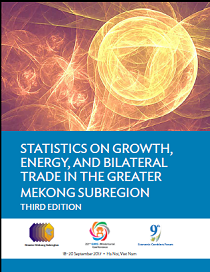
Statistics on Growth, Energy, and Bilateral Trade in the Greater Mekong Subregion (Third Edition)
The third edition of the Greater Mekong Subregion Statistics booklet includes two new chapters: the Energy Sector and Bilateral Trade.
Developing transport infrastructure in tandem with policies and procedures for crossing borders and promoting trade has been central to efforts to interconnect the Greater Mekong Subregion countries.
The Subregional Transport Forum reviews, coordinates and monitors regional transport plans and projects of GMS member countries.
Transport lies at the heart of Greater Mekong Subregion cooperation. The development of physical infrastructure, such as roads and bridges, in tandem with policies and procedures for crossing borders and developing trade along key routes, has been central to efforts to forge a truly interconnected subregion.
Physically connecting the countries of the subregion was one of the first initiatives of the GMS program when it was founded in 1992. The countries of the Greater Mekong Subregion have acknowledged that in order to cooperate in trade, tourism, and investment, and to realize the other benefits of the region, they must expand the road links and border crossings that connect them.
This is being done through the development of “economic corridors,” which are geographic areas, often along major highways, where a variety of development projects are undertaken to maximize their development benefits. This might include projects involving infrastructure, laws and regulations, market development, and the improvement of urban centers. Economic corridors bring a wide range of benefits, far beyond what single projects deliver in terms of development impact.
The three main GMS corridors—the East–West, North–South and Southern economic corridors—have improved the lives of millions of people in the Greater Mekong Subregion. These corridors are being enhanced with secondary roads that extend their benefits to nearby communities most in need, and other roads that link to strategic seaports in the subregion. The regulatory details of how people and goods can best move along these corridors are also currently being worked out.
The GMS Economic Cooperation Program Strategic Framework 2030 (GMS-2030) will prioritize intermodal approaches, facilitate cross-border transport, and seek improvement in logistics, asset management, and road safety. Given the rise in GMS economic density, and with respect to its environmental considerations, GMS-2030 aims to ensure the development of railway networks; sea, river, and dry ports; and inland waterways. Investments in airports to improve connections with the rest of Asia and the world will be essential, as will the development of secondary roads that will link to main corridors to expand the benefits to poorer communities. An effort will be made to integrate urban transport with the GMS transport network. GMS-2030 was endorsed and adopted at the 7th GMS Summit of Leaders in September 2021. It aims to provide a new setting for the development of this subregion for the next decade.
Related
• GMS Transport Sector Strategy 2030
• GMS Transport Strategy 2006–2015
Focal Persons at the Asian Development Bank
Steven Schipani
Water and Urban Development Sector Office
Sectors Group
Dee Suvimol Thanasarakij (Ms.)
Executive Director,
Mekong Tourism Coordinating Office
www.mekongtourism.org
Other Concerned Staff & Consultants
Zulfia Karimova, EAPF
Regional Cooperation and Integration Unit
Central and West Asia Department
Mark Bezuijen
Agriculture, Food, Nature, and Rural Development Sector Office
Sectors Group
Asadullah Sumbal
Regional Cooperation and Integration Unit
Southeast Asia Department
Alma Canarejo
Regional Cooperation and Integration Unit
Southeast Asia Department/GMS Secretariat
Send inquiries to GMS Secretariat.

The third edition of the Greater Mekong Subregion Statistics booklet includes two new chapters: the Energy Sector and Bilateral Trade.

This document provides a snapshot of the Greater Mekong Subregion's performance from 1992-2014, highlighting growth in output and merchandise trade, developments in information and communication technology, and trends in subregional integration.
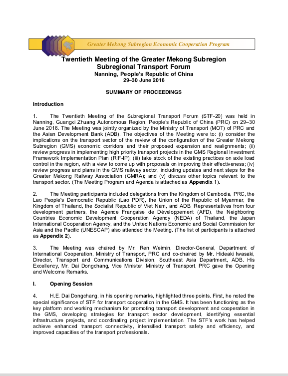
The Twentieth Meeting of the Subregional Transport Forum (STF-20) was held in Nanning, Guangxi Zhuang Autonomous Region, People’s Republic of China on 29–30 June 2016.
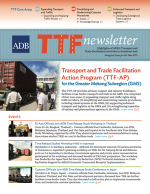
The TTF newsletter highlights the ADB’s Transport and Trade Facilitation Activities in Southeast Asia.
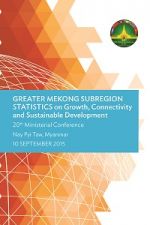
Timely availability of information, data, and indicators at the country and project levels allows for the measurement of progress – the achievement of policy objectives, as well as impacts and outcomes of target-driven projects.
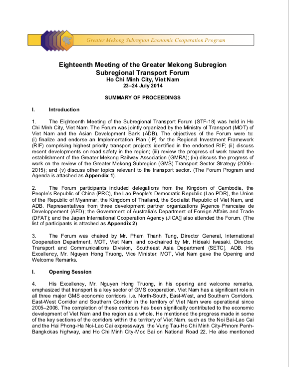
The Eighteenth Meeting of the Subregional Transport Forum (STF-18) was held in Ho Chi Minh City, Viet Nam. The Forum was jointly organized by the Ministry of Transport (MOT) of Viet Nam and the Asian Development Bank (ADB).
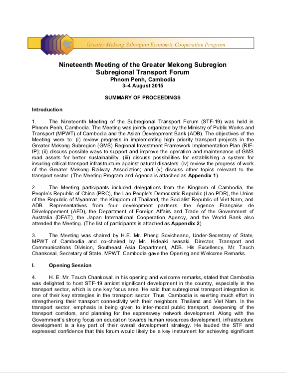
The Nineteenth Meeting of the Subregional Transport Forum (STF-19) was held in Phnom Penh, Cambodia.
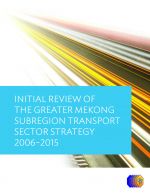
This assessment indicates a mixed performance for the Transport Sector Strategy Study, 2006-2015 based on an assessment of the overarching goals upon which the study was based.
The Forum was jointly organized by the Ministry of Transport (MOT) of Thailand and the Asian Development Bank (ADB).
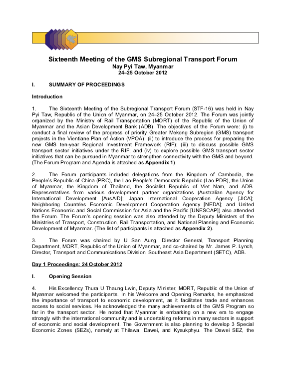
The Sixteenth Meeting of the Subregional Transport Forum (STF-16) was held in Nay Pyi Taw, Republic of the Union of Myanmar, on 24–25 October 2012. The Forum was jointly organized by the Ministry of Rail Transportation (MORT) of the Republic of the Union of Myanmar and the Asian Development Bank (ADB).